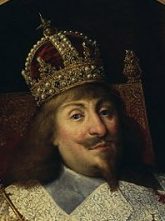Swedish Crown
Swedish Crown refers to the monarchy of Sweden, a constitutional and hereditary monarchy with a parliamentary system. The Swedish Crown has been a pivotal institution in the history and governance of Sweden, symbolizing the continuity of the nation's sovereignty and serving as the head of state. The current monarch, as of the last update, is Carl XVI Gustaf, who ascended to the throne on September 15, 1973.
History[edit | edit source]
The history of the Swedish Crown can be traced back to the early medieval period, with the establishment of a unified Swedish kingdom in the 12th century. Over the centuries, the monarchy has played a crucial role in the political, social, and economic development of Sweden. The form of governance has evolved from an absolute monarchy to its current constitutional form, where the monarch's duties are largely ceremonial and symbolic.
In the 16th century, under the rule of Gustav Vasa, Sweden became a hereditary monarchy, marking the end of elective kingship. This period also saw the establishment of Sweden as a major European power, particularly during the 17th century under the rule of kings like Gustavus Adolphus and Charles XII. The 18th and 19th centuries, however, were marked by significant political reforms and the gradual reduction of royal power, culminating in the adoption of the 1974 Constitution, which formally established the current parliamentary system.
Constitutional Role[edit | edit source]
Under the current Swedish Constitution, the monarch's role is primarily ceremonial, with no executive or legislative powers. The monarch performs duties such as opening the Riksdag (the Swedish Parliament), representing Sweden at official state functions, and receiving foreign dignitaries. The monarch is also the formal head of the Swedish Armed Forces and has a ceremonial role in the Church of Sweden.
Succession[edit | edit source]
The Act of Succession is part of the Swedish Constitution, governing the line of succession to the Swedish throne. Historically, the throne was passed to male heirs, but a change in the law in 1980 allowed for female succession, making Crown Princess Victoria the heir apparent, followed by her children.
Royal Family[edit | edit source]
The Swedish Royal Family consists of the monarch, the consort, their children, and their spouses. Members of the Royal Family undertake various official, ceremonial, diplomatic, and representational duties on behalf of Sweden and the monarch.
Crown Jewels[edit | edit source]
The Swedish Crown Jewels, also known as the Regalia, are symbols of the monarchy's authority and consist of crowns, scepters, orbs, swords, and other items used during coronations and royal ceremonies. These items are kept at the Royal Palace in Stockholm and are displayed to the public in the Treasury.
Cultural and Symbolic Significance[edit | edit source]
The Swedish Crown holds significant cultural and symbolic importance, representing the nation's history, identity, and unity. The monarchy enjoys widespread support among Swedes, often cited as a stabilizing factor and a source of national pride.
This monarchy-related article is a stub. You can help WikiMD by expanding it.
Search WikiMD
Ad.Tired of being Overweight? Try W8MD's physician weight loss program.
Semaglutide (Ozempic / Wegovy and Tirzepatide (Mounjaro / Zepbound) available.
Advertise on WikiMD
|
WikiMD's Wellness Encyclopedia |
| Let Food Be Thy Medicine Medicine Thy Food - Hippocrates |
Translate this page: - East Asian
中文,
日本,
한국어,
South Asian
हिन्दी,
தமிழ்,
తెలుగు,
Urdu,
ಕನ್ನಡ,
Southeast Asian
Indonesian,
Vietnamese,
Thai,
မြန်မာဘာသာ,
বাংলা
European
español,
Deutsch,
français,
Greek,
português do Brasil,
polski,
română,
русский,
Nederlands,
norsk,
svenska,
suomi,
Italian
Middle Eastern & African
عربى,
Turkish,
Persian,
Hebrew,
Afrikaans,
isiZulu,
Kiswahili,
Other
Bulgarian,
Hungarian,
Czech,
Swedish,
മലയാളം,
मराठी,
ਪੰਜਾਬੀ,
ગુજરાતી,
Portuguese,
Ukrainian
Medical Disclaimer: WikiMD is not a substitute for professional medical advice. The information on WikiMD is provided as an information resource only, may be incorrect, outdated or misleading, and is not to be used or relied on for any diagnostic or treatment purposes. Please consult your health care provider before making any healthcare decisions or for guidance about a specific medical condition. WikiMD expressly disclaims responsibility, and shall have no liability, for any damages, loss, injury, or liability whatsoever suffered as a result of your reliance on the information contained in this site. By visiting this site you agree to the foregoing terms and conditions, which may from time to time be changed or supplemented by WikiMD. If you do not agree to the foregoing terms and conditions, you should not enter or use this site. See full disclaimer.
Credits:Most images are courtesy of Wikimedia commons, and templates Wikipedia, licensed under CC BY SA or similar.
Contributors: Prab R. Tumpati, MD

